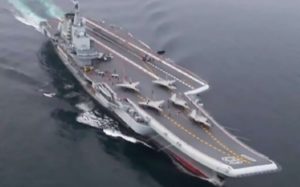by WorldTribune Staff, December 26, 2016
China’s lone aircraft carrier and five other vessels were spotted passing near Taiwan on Dec. 26 in what was described as a “warning to the United States.”
The Liaoning carrier’s armada passed about 90 nautical miles south of Taiwan’s most southerly point via the Bashi Channel that runs between Taiwan and the Philippines, according to reports. The ships then passed southeast of the Pratas Islands, also controlled by Taiwan, before heading southwest.

Senior Taiwan opposition Nationalist lawmaker Johnny Chiang said the Liaoning exercise was China’s signal to the United States that it has broken through the “first island chain,” an area that includes Japan’s Ryukyu Islands and Taiwan.
The Chinese state-run newspaper Global Times said in an editorial: “The Chinese fleet will cruise to the Eastern Pacific sooner or later. When China’s aircraft carrier fleet appears in offshore areas of the U.S. one day, it will trigger intense thinking about maritime rules.”
After U.S. President-elect Donald Trump took a call from Taiwanese President Tsai Ying-wen, the Global Times said in an editorial that “it might be time for the Chinese mainland to reformulate its Taiwan policy, make the use of force as a main option and carefully prepare for it.”
Beijing confirmed last year that it is building a second aircraft carrier but its launch date is unclear.
China claims most of the South China Sea as its sovereign territory. Brunei, Malaysia, the Philippines, Taiwan and Vietnam also have claims.
Meanwhile, China has tested the latest version of its fifth-generation stealth fighter, state media reported on Dec. 26.
The newest version of the J-31 — now renamed the FC-31 Gyrfalcon — is China’s answer to the U.S. F-35, the world’s most technically advanced fighter.
The new FC-31 has “better stealth capabilities, improved electronic equipment and a larger payload capacity” than the previous version which debuted in October 2012, the newspaper said, quoting aviation expert Wu Peixin.
“Changes were made to the airframe, wings and vertical tails which make it leaner, lighter and more maneuverable,” Wu told the paper.
The fighter is expected to sell for around $70 million, the article said, aiming to take market share away from more expensive fourth-generation fighters like the Eurofighter Typhoon.
